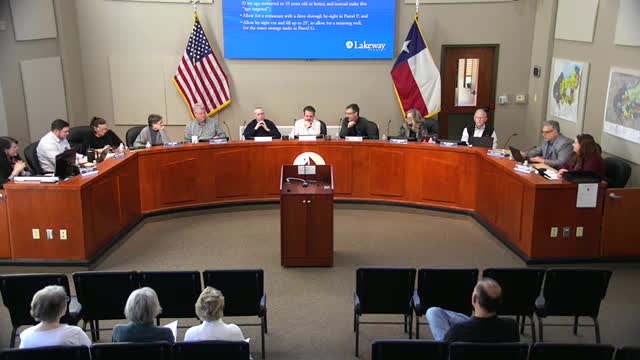Developers present housing plans including condos and cottages at Lakeway meeting
March 05, 2025 | Lakeway, Travis County, Texas
This article was created by AI summarizing key points discussed. AI makes mistakes, so for full details and context, please refer to the video of the full meeting. Please report any errors so we can fix them. Report an error »

On March 5, 2025, the Lakeway Zoning and Planning meeting addressed significant developments regarding the Jovi project and surrounding areas, highlighting changes in zoning regulations and construction plans that could impact the community.
The meeting began with discussions about the Planned Unit Development (PUD) involving Jovi, a key player in the local real estate market. Jovi is part of a property owners association that includes Hayes Development and Legends, indicating a collaborative approach to development in the area. A primary focus was the transition of certain residential units from rental to sale, specifically 21 cottages that are now being proposed for sale rather than for rent. This change aims to reduce the availability of rental properties, responding to community concerns about housing availability.
Another critical topic was the construction challenges posed by the steep topography of the site, particularly concerning a water tower that affects the design and zoning of the area. The steep grade necessitates the construction of taller retaining walls to ensure safety and compliance with city codes. The proposal to increase the maximum height of these walls from 16 to 25 feet was discussed, with city officials emphasizing the importance of transparency in the zoning document to facilitate future planning and construction.
The meeting also touched on the demographic focus of the Jovi project, which aims to attract residents aged 55 and older. While the developer expressed a desire to maintain this age restriction as part of their marketing strategy, they acknowledged that formal zoning requirements could complicate financing options. This highlights the delicate balance between regulatory compliance and market demands in residential development.
Parking arrangements were another point of discussion, with plans to assign one parking space per unit to further clarify the project's target demographic and limit the number of vehicles per household. This strategy is intended to ensure that the development remains attractive to its intended audience while managing potential congestion in the area.
In conclusion, the Lakeway Zoning and Planning meeting underscored the complexities of urban development in a rapidly growing community. The proposed changes to zoning regulations and the focus on specific demographics reflect ongoing efforts to address housing needs while navigating the challenges posed by the local environment. As the project progresses, further discussions and approvals will be necessary to align community interests with development goals.
The meeting began with discussions about the Planned Unit Development (PUD) involving Jovi, a key player in the local real estate market. Jovi is part of a property owners association that includes Hayes Development and Legends, indicating a collaborative approach to development in the area. A primary focus was the transition of certain residential units from rental to sale, specifically 21 cottages that are now being proposed for sale rather than for rent. This change aims to reduce the availability of rental properties, responding to community concerns about housing availability.
Another critical topic was the construction challenges posed by the steep topography of the site, particularly concerning a water tower that affects the design and zoning of the area. The steep grade necessitates the construction of taller retaining walls to ensure safety and compliance with city codes. The proposal to increase the maximum height of these walls from 16 to 25 feet was discussed, with city officials emphasizing the importance of transparency in the zoning document to facilitate future planning and construction.
The meeting also touched on the demographic focus of the Jovi project, which aims to attract residents aged 55 and older. While the developer expressed a desire to maintain this age restriction as part of their marketing strategy, they acknowledged that formal zoning requirements could complicate financing options. This highlights the delicate balance between regulatory compliance and market demands in residential development.
Parking arrangements were another point of discussion, with plans to assign one parking space per unit to further clarify the project's target demographic and limit the number of vehicles per household. This strategy is intended to ensure that the development remains attractive to its intended audience while managing potential congestion in the area.
In conclusion, the Lakeway Zoning and Planning meeting underscored the complexities of urban development in a rapidly growing community. The proposed changes to zoning regulations and the focus on specific demographics reflect ongoing efforts to address housing needs while navigating the challenges posed by the local environment. As the project progresses, further discussions and approvals will be necessary to align community interests with development goals.
View full meeting
This article is based on a recent meeting—watch the full video and explore the complete transcript for deeper insights into the discussion.
View full meeting
